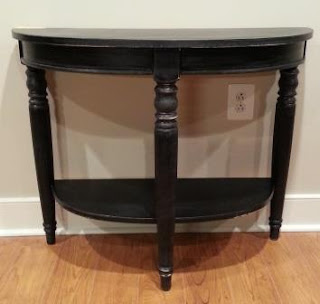When I found a damaged demi-lune table I immediately had visions of a graceful entryway, maybe with a large leaning mirror and flowers in perfect bloom.
Well, that hasn't quite materialized.... Let's chat about great expectations and furniture painting frustrations.
Here is where it all began.
A curved table with graceful lines (the photo below is after I had sanded it, but picture it all shiny).
But ahhh, look a little closer and you can see some damage, a large chip out of the back left corner.
Now, I could have stopped right there and given it away, or just decided to cover the chip with a cloth and call it a day. But where is the learning experience in that? I decided I would fix the chip AND repaint the table in a lovely shade of blue.
The first part was fixing the chip, about 4 inches long and 1 inch deep at the edge.
I decided to make a temporary base so that the bottom of the repair would be in line with the rest of the table top. I did this by attaching a scrap piece of wood (leftover from the slipper chair surgery) with some light glue. I would later remove the piece of scrap wood, so I didn't want it attached too strongly.
The next step was to build up layers, made of bits of wood shims and glue. Yes, again I decided to buy some supplies, total cost was under $10.
I broke off pieces of the shim to glue along the angle of the original table top. You can see from this side view that the original chip was wedge shaped. My strategy was to get the top piece attached and somewhat flush with the table surface and then fill in underneath. This may not be woodworking orthodoxy, but that's what happens when you are making it up as you go along.
Eventually I got to a point where I couldn't cram any more gluey tiny shim pieces into the gaps.
At this stage the work with shims was over and I decided to try to start using wood filler to fill in the holes.
Wood filler can dry a little rough, so I had a few rounds of filling and sanding.
Eventually I got to this point, where the top and sides seemed smooth enough.
I was pretty proud of my repair, it was solid and I'd managed to be patient and let the glue dry between layers.
Now, what I could have (and maybe should have) done was the paint the repaired chip black and call it done. But smokey blue colors haunted my dreams and after reading all about it I thought I'd give non-toxic milk paint a try.
The mixing and painting was pretty easy, and I have to say I was impressed with the LACK OF SMELL. Milk paint has no toxic fumes, it is water-based, so I didn't worry about getting headaches or killing brain cells (which is one reason I tend to shy away from painting things). Also it comes in a powder form, so you don't have to worry about storing awkward cans of unused liquid paint. yet another bonus is that it dries pretty quickly.
This picture was after 1 or 1.5 coats. You can see the black spot on the leg where the milk paint had flaked, or chipped, off, a foreshadowing things to come.
I was so excited to finish this table because the color was lovely, and at first everything looked good....
...as it dried I started to see more and more flaking, and I thought to myself "oh crap. Even though I sanded all the surfaces I should have bought the bonding agent."
To be continued.












